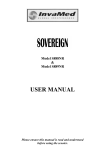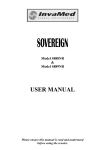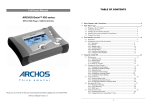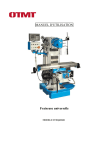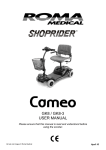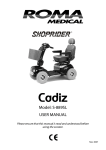Download Roma Medical Shoprider S-889SL Service manual
Transcript
Scooter Service Manual Index 1. Safety advice. 2. Warranty Information. 3. Tools required. 4. Product identification. 5. Tiller head components checks and re-fitting. 6. Body panel removal. 7. Seat removal and adjustments. 8. Wheels and tyres. 9. Main controller checks. 10. Battery and battery charging information. 11. Battery removal and testing. 12. Brake removal and testing. 13. Motor brush removal and checks. 14. General checks and tips. 15. Controller errors and diagnostic guide. 16. Troubleshooting guide. 17. Annex & Wiring diagrams. 2 1. Safety Advice Always observe a safe working practice. Scooters and their component parts such as batteries and subassemblies can be very heavy so care must be taken when lifting and carrying/moving. Always seek the assistance of a colleague or use suitable lifting equipment wherever possible. Be aware of where component parts are placed when dismantling a scooter. Do not leave parts in walkways or in places where they may fall and cause injury (edge of a bench etc.). Never attempt maintenance or repair if the scooter is connected to the mains power supply. Also disconnect the batteries to prevent any unexpected movement that could result in injury. 3 2. Warranty Information This is the text from the rear cover of the user manuals: “This is to certify that your Roma Medical/Shoprider® product is warranted for a period of 12 months from the date of original purchase. This warranty is not transferable. Should a defect or operating fault arise within this period the Dealer from where the product was originally purchased should be notified immediately. Failure to register the fault may invalidate the warranty. Roma Medical warrants that if a fault occurs within this period due to faulty workmanship or materials that the product will be repaired (or replaced at the Companys discretion) free of charge. Any unauthorised modifications will invalidate the warranty. Parts which are subjected to normal wear and tear, accidental damage, neglect or misuse are excluded from this warranty. Normal wear and tear includes tyres, chassis covers, bulbs, seat coverings etc. Component parts replaced outside this period carry a six-month warranty. (Standard terms and conditions apply for this period).” Please note: Battery warranties MUST be accompanied by a valid test certificate. A multimeter reading will not be sufficient to determine a batterys performance. 4 3. Tools Required The following list is a guide to what tools are required to comfortably maintain powered scooters. • • • • • • • • • • • • • • • • • Multimeter Set of metric allen keys Socket set (metric) Set of open end spanners from 3mm to 15mm Magnetic tipped screwdriver set Bondlock B270 / B220 thread locking compound Torque wrench – up to 25Nm rated Wire stripper Crimp tool and crimps Mole grips Rubber mallet Stanley knife Circlip pliers Pliers (long nose and combination) Tyre pump and pressure gauge Tape measure and metal rule Soldering iron Recommended Stock Spares Although Roma Medical carries a comprehensive stock of spare parts it is recommended that certain parts should be to hand, these would include:Motor Brushes Blade Fuses Various Nyloc Nuts and Washers (always replace nyloc nuts for new) Wig Wag Potentiometers (see part 12) Recovery Fuses (see part 13) 5 4. Product Identification Each scooter will have a unique serial number allowing it to be traced to its original date of sale and the serial numbers of the original motor, gearbox, brake and controller. The scooter will also have a product ID that is located on a label on the rear chassis frame on most models. Alternatively, if you have the model name; this can be cross-referenced to the product ID. Product ID SN7-3/7 SL-8 GK8 GK9 SL7 S787M S787NA S787L S778NR S888NR S889NR S888SLR S888SL S889SL S889XLSB S889DXS S778XLS S889XLS S889XLSBN S889XLSBN/CAN Product Name Sunrunner 3 / 4 Superlite 4 Cameo Paris Altea Capri Whisper Napoli Sovereign 3 Sovereign 4 Deluxe Perrero Perez Cadiz Milan Monza Torino Madrid Cordoba Traveso Please see image below for an example of the serial number label. Always refer to the serial number and product ID when ordering spare parts or contacting the Roma Medical technical staff. 6 5. Tiller Head Component Checks And Re-fitting There are a few components within the tiller head which can be replaced / maintained: Throttle (Wig Wag) Potentiometer (5kΩ) Maximum Speed Variable Resistor (20kΩ)* Battery Meter* Charge Socket* Light / Horn Buttons* Indicator Switch* Hi-Lo Speed Setting Switch (Class 3 scooters only)* Key switch* * Should these components become faulty the function of that particular component will fail and repair is a simple replacement (check switches / buttons for continuity). Should the throttle potentiometer fail / become mis-aligned you will hear a bleep error (see page 11). Wig Wag Potentiometer Replacement There are two types of potentiometer which both have the same 5kΩ value. Please see the image below to determine which type is required before replacing. 7 Continued… Please see above image for wiring details for the potentiometer. It is imperative that the ‘pot’ is set in it’s neutral position for it to work. Failure to do this will result in the bleep error as mentioned previously. Generally this can be done by aligning the slot in the shaft with the middle terminal (2) and switching the scooter on, if there is a bleep error switch the scooter off and re-align the pot and switch on again until the bleep error disappears. A multimeter may be required to ‘fine tune’ the pot to get the neutral position. Use wire 2 as the common and test either side terminal, the resistance should measure between 2.5 and 2.6kΩ each side. Use a flat bladed screwdriver in the slot to adjust the pot. When neutral is achieved, tighten the grub screws which hold the wig-wag lever onto the shaft of the pot. Reversing the polarity To reverse the polarity (reverse the wig-wag function) simply desolder the two outer wires (1 & 3) and swap their position and resolder. 8 Battery Meter Replacement Depending on the age and model of the scooter, there will be either a ribbon type meter which consists of a LED display and PCB control board connected by a grey ribbon type cable or an integrated type. The newer battery meter is an integrated design where all components are combined. The older ribbon type can easily be replaced for the newer integrated design. The battery meter may have a plug connection or be hard soldered to the electronics. The picture below shows the two types with plug connections. The soldered types are identical but have bared wire ends. 9 Maximum System Speed Variable Resistor Some models have a variable resistor ‘hidden’ inside the tiller control assembly which is not intended for user interaction. This variable resistor dictates the maximum available speed the scooter can achieve. As standard this will be set to allow the scooter to achieve a maximum of 4mph (the legal maximum for class 2 scooters). The value of the variable resistor is 10kΩ. (see image below for typical location). 10 6. Body Panel Removal Rear chassis covers are held in place with Velcro strips for ease of access to the working components of the drive train and controller. The seat should be removed before taking off the rear chassis cover. The front chassis covers are secured by screws, which are located under the carpet or rubber mat depending on the model of scooter please see image below. The example shown is a S889XLSBN – Cordoba which has 8 screws (circled) securing the cover to the main chassis of the scooter. Note: The tiller assembly must be removed before attempting to replace the front chassis cover (except for models 889SL/XLS & XLSB. These have a cut-out to enable the cover to be removed by sliding it to the front of the scooter). The tiller can be removed by unplugging the loom and undoing the bolts ’A’ as indicated in the image. 11 7. Seat Removal Before undertaking maintenance or repair work on the rear part of the scooter, you will have to remove the rear chassis cover, which will involve the removal of the seat. Depending on the model, you will have a red ‘paddle’ like lever or a smaller yellow tipped lever on the right underside of the seat. The lever will also allow the user to swivel the seat for easier transfers. To remove the seat simply pull up on the red or yellow lever and simultaneously lift the seat away from the seat post/adapter. Caution should be taken when lifting the larger type captain seats (20kgs) these are heavier than the standard seat (17kgs). 12 8. Wheels & Tyres The smaller scooters will be fitted with one-piece plastic rims and solid tyres, the larger scooters have split aluminium rims and either pneumatic or infill tyres. Whenever replacing tyres or inner tubes it is essential that the tyres are completely deflated before attempting any replacement. Above is the breakdown of a typical rear wheel assembly which consists of an inner and outer rim; these are held together by four bolts. The wheel is mounted using a central 8mm bolt which should be tightened to 15Nm torque. Always use a thread locking compound to the specification previously mentioned when re-assembling the wheel and on the main axle bolts when re-fitting the wheel to the scooter. The chart below shows the manufacturers recommended tyre pressure for different sized wheels. Tyre pressure may be reduced by 3 psi. to give a smoother ride over small bumps. Wheel Size 2.80 x 2.50 [8 inch] 260 x 85 [10 inch] 330 x 100 [13 inch] Tyre Pressure (psi) Min. Max 25. 25. 25 22 22 22 25 25 25 13 9. Main Controller Checks Depending on the age of your scooter you could have an analogue or digital controller. Older analogue AC type controllers can be replaced with the newer digital AC2 type controllers. Penny & Giles ‘Solo’ controllers can still be obtained from Penny & Giles or alternatively be repaired. An interface loom is available to replace ‘Solo’ controllers with the ‘AC2’ digital type. There are very few components within the controller which can be serviced or replaced. There is a low value automotive blade type fuse ‘B’ (normally 1 – 3amp rating) which protects the controller, and a flat yellow recovery fuse ‘A’ which protects the controller during charge cycles. Some controllers may have a blade type fuse instead of the recovery fuse – these will be rated at 5, 10 & 15amp depending on the controller. Component Failure Should ‘A’ become faulty, the scooter will appear to take very long periods to charge. This may also be tested by checking the voltage across the batteries when charging. Whilst charging up to 14 volts may be measured at each battery. If there is no power difference at the batteries when on or off charge replace this component with either a new recovery fuse or the fuse holder with the correctly rated fuse. Should a fuse holder be fitted, the charger will indicate a circuit fault (red flashing led) if the fuse blows. 14 Continued… Should component ‘B’ fail there will appear to be no power at all when the scooter is switched on and all other fuses are intact. Simply replace the fuse inside the holder. The PCB may also suffer from water ingress or condensation if the scooters are stored outdoors. This may appear obvious if the control box has standing water in it. If it is thought that moisture contamination has occurred, the PCB can be removed to allow it to dry. DO NOT apply direct heat to the PCB or place it on a heater or radiator, allow it to dry at normal room temperature. Sometimes, moisture can permanently damage the PCB and the main controller will need to be replaced or repaired. 15 10. Battery And Battery Charging Information Each scooter is fitted with two 12 volt sealed, maintenance free gel or AGM (absorbent glass mat) batteries. These are connected in series to provide the 24-volt operating voltage. Batteries (if faulty) will normally fail within the first three months of use, after this period it is normally incorrect maintenance or charging procedure which will lead to failure. * Charger type – T = Transformer S = Switch mode Product ID Product Name SN7-3/7 SL-8 GK8 GK9 SL7 S787M S787NA S787L S778NR S888NR S889NR S888SLR S888SL S889SL S889XLSB S889DXS S778XLS S889XLS S889XLSBN S889XLSBN/CAN Sunrunner 3 / 4 Superlite 4 Cameo Paris Altea Capri Whisper Napoli Sovereign 3 Sovereign 4 Deluxe Perrero Perez Cadiz Milan Monza Torino Madrid Cordoba Traveso Battery Capacity (Ah) 17 10 10 21 10 12 12 21 34/36 34/36 45 34/36 34/36 34/36 – 45 73/75 34/36 – 73/75 73/75 73/75 73/75 34/36 - 73/75 Charger (Type/Output) T – 3amp S – 1.2amp S – 1.2amp T – 3amp S – 1.2amp S – 1.2amp S – 1.2amp T – 3amp T – 3amp T – 3amp T – 3amp S – 8amp** T – 3amp T – 3amp S – 8amp** S – 8amp** S – 8amp** S – 8amp** S – 8amp** S – 8amp** ** This model has a cooling fan which will continue to operate after the charge cycle has completed. Charging Each scooter is supplied with a charger – this may be either a switch type or transformer type. The switch mode charger will automatically stop charging when the cycle is complete. The transformer type will revert to a ‘trickle’ charge mode when the cycle is complete. Charging status will be indicated by LEDs on the charger. Red indicates a disconnection, flashing green or amber indicates charging and a continuous green LED indicates the charging cycle is complete. Avoid interrupting the charge cycle as this may damage the batteries. 16 11. Battery Removal. Should a problem occur which would indicate a battery fault; each battery should be tested to find the faulty cell. Industry standard devices such as the Alpha Bat tester can be used to give a percentage of the battery’s true capacity rating. ALWAYS charge the scooter fully before undertaking any battery tests. DO NOT use devices that are designed for use with automotive type batteries. These are not designed to test deep cycle batteries used with scooters and can cause permanent damage to a battery. A simple test to indicate a possibly failed battery is to run the scooter under load and take a voltage reading of each battery with a multimeter. To do this, remove the shroud covering the batteries and connect the multimeter to one of the batteries. Re-fit the seat and drive the scooter a small distance. The battery voltage should not fall lower than about 11 volts. Repeat the test for each battery. Overall system power can be tested via the charge socket with a multimeter. Switch the scooter on and carefully place the multimeter probes in the corresponding sockets (1 & 2) as shown in the image. A fully charged scooter should give a reading between 25 & 26 volts. Ensure the multimeter is set to measure voltage. DO NOT short circuit poles 1 & 2. 17 12. Brake Removal And Testing Old Type New Type The electromagnetic brake is located on the end of the motor and can be removed by undoing the three screws. When 24v is applied, the brake will release allowing the scooter to drive (this can be heard by an audible ‘click’). If the scooter fails to move there may be a problem with the wigwag potentiometer or the brake itself may be faulty. Use a multimeter to determine if 24v is reaching the brake when the throttle is applied. If there is 24v measured at the plug and the brake fails to operate the brake is either faulty or possibly stuck. It is easier to diagnose brake faults when the brake is removed from the motor as you can see the internal mechanism physically release and lock. A brake may stick if the scooter has not been used for a prolonged period of time. If power is reaching the brake but it does not release check to see if there is any corrosion inside the end of the brake (by the plate with the hexagonal hole). If necessary, use a release agent such as WD40 to lubricate the brake and re-apply power to try and release the brake. If the brake is releasing you will be able to move the internal plate with the hexagonal cutout when power is supplied. The brake should show continuity when tested with a multimeter – if this is not the case, replace the brake. 18 13. Motor Brush Removal And Checks Each motor has a pair of carbon brushes. Depending on the model, the brushes will be accessible by removing brush caps (Type 1) or by removing the brake from the motor and removing the back plate from within the motor (Type 2). Type 2 Type 1 If you have a Type1 motor and the brushes are mounted vertically, it is possible to remove the motor and refit it after turning it through 90 degrees, this will enable easier future access to the brush caps. When new, the carbon brushes will be approximately 15mm long. Care should be taken when re-fitting the brush caps – gently tighten until the cap securely locates, do not over tighten as this can cause the brush cap to break. When changing the brushes it is a good idea to make sure the commutator contacts are clean. Look down the brush housing to see for any visible signs of dust/debris. If necessary clean out the motor with compressed air or electrical contact cleaning spray. DO NOT use any form of lubricating oil to clean the motor internals. For motor draw specifications please see annex (X) 19 14. General Checks And Tips Whenever diagnosing problems there are several areas which should be checked as part of the fault finding process. In addition to the previously mentioned checks please investigate the following:Check the cable tie which holds the loom in place at the bottom of the tiller stem. If this has been over tightened it may cause an intermittent fault due to the loom becoming damaged due to the excessive pressure of the tie. Where appropriate, the large orange main loom plugs should be examined for any contamination or damage. Clean thoroughly where necessary. If any damage is present, replace the loom. 20 Continued… Examine the motor, if it has a microswitch to indicate freewheel engagement, check the operation of the switch using the continuity mode on a multimeter. If the switch does not open or close in either lever position replace the switch. Checklist The most common problem with the scooters is in the BATTERIES. Load testing batteries is a good first step in troubleshooting scooter problems. Also check the battery cables for secure terminal connection. Batteries are guaranteed for 1 year but from experience and dependent on the user this time can be considerably extended. Faults that occur with batteries will appear in the first 3 months of use, later than this normally is due to misuse. Measure motor voltage at the white 4-pin connector going to the motor. (The thicker wires are the motor wires). This should measure 0 volts when you first turn on scooter. Press throttle to increase the speed, this will increase to a maximum of 24 Volts. Measure brake voltage at the white 2-pin connector going to the brake. This should measure 0 volts when the brake is engaged (either with scooter powered on or off). Once you engage the throttle, the brake voltage should increase to 24 volts, thus releasing the brake. (If less than 24 volts is going to the brake, the brake may only be partially releasing.) 21 Intermittent problems are usually caused by faulty wiring. Check all connections and run a continuity test on the wiring looms. If, after thoroughly troubleshooting the scooter, you have any further questions, please call the Shoprider service department and we will be glad to assist you. For warranty replacement, have the Model Number, Serial number of the scooter and the part, and purchase date of the scooter ready. We will arrange for our Returns Form to be sent with the warranty replacement parts. Please check the following also when examining a scooter which appears to be faulty:Circuit breakers Battery fuses Control box fuse All loom connections Motor brushes and brush caps Battery voltages Please see below for the required settings that you will need when using the multimeter. 22 Cameo GK8 & Paris GK9 Contact Maintenance Dismantle the scooter as per user manual and thoroughly clean both sets of connectors (front and rear) with an alcohol based solvent. Apply an electrical contact treatment grease/gel such as Electrolube SGB20S to both sets of connectors and re-assemble the scooter. Front Connectors Rear Connectors Battery Pack Connectors Chassis Battery Connectors Underside of battery pack We also recommend that the connectors between the battery pack and the main chassis are treated at the same time to prevent any carbon build up (round plate connectors and pins). Simply reassemble the scooter as per user manual after these procedures have been undertaken. It is recommended that you repeat this procedure on a regular basis. 23 Lubrication Shoprider Scooters should be lubricated in the following areas as indicated below. Take care when lubricating to avoid drips or spills on carpets and floors. Breather Cap Fill / Drain Plug Transaxle The Transaxle is a sealed unit and should not need lubrication unless it is leaking or has developed a squeak or noise. At the side of the transaxle there is a porthole cover that will allow access for oil drainage or filling. The unit is sealed for life and will not need attention under normal conditions. On the top of the transaxle/gear box there is what appears to be a grease nipple, this is not so and serves only as a breather hole. We recommend the use of Castrol semi-fluid gear gel or equivalent grease depending on what the Transaxle contains. Sealed units with no breather holes units are fitted with Molybdenum Disulphide paste, after July 2006 Gel is being used. NOTE: It is very important that the breather cap is opened before the scooter is put into service. Failure to do this may cause a pressure build up within the gearbox. See Annex for transaxle updates for the 888/9NR models. 24 15. Controller Errors and Diagnostic Guide Category Error Status Battery Voltage Battery Error Alarm Alarm- Alarm- Probable Cause Span On Off (sec) Time Time (sec) (sec) 0.3 0.2 0.1 1.Low Battery 2.Battery wiring Fault 3.Battery old. Troubleshooting Replace the battery if battery is old. Check and correct the battery wiring. If battery voltage is low – recharge. Motor/Brake Current Current Error 5 4 1 Abnormal current in motor / brake. Motor/Brake Off-line Detection Error 0.4 0.3 0.1 Motor / brake off line error. Brake cable probably broken while your scooter is switched on along with alarm. Motor cable probably broken while the throttle is activated along with alarm. 2 0.2 1.8 Potentiometer Reset / replace the assembly potentiometer damaged or assembly. short circuit. Potentiometer neutral point needs resetting. Accelerating Speed Device Command Error Check the motor / brake for any mechanical or wiring error. Repair or replace where necessary. Check that freewheel is engaged, reengage drive and turn the scooter on and off. Check motor and brake cables for damage. Repair / replace where necessary. Check motor brush caps are secure and brushes are locating correctly.* * If the motor brushes housings are mounted vertically, it maybe necessary to remove the motor from the drivetrain to gain access to the lower brush. It is possible to turn the motor through 90° and re-fit the motor to allow for easier future servicing. 25 16. Scooter Troubleshooting Guide This guide covers the most common queries. Please refer to this guide as your first port of call. Fault Finder • No power, the scooter will not move with the key switched on. • The scooter has reduced power, limited speed and range. • The scooter has no power or reduced power in forward or reverse. • Erratic throttle control, the scooter hesitates in forward or reverse, dead spots in throttle control travel. • The horn sounds when the throttle applied. • The scooter suddenly stops while in motion and brakes engage immediately. • The circuit breaker trips repeatedly. • Reduced braking power, engaging slowly and slipping on slopes. • The brake will not disengage or engage. • The motor runs but the scooter does not move. • Excessive noise from the transaxle / gearbox. • The scooter pulls to one side. • Excessive play in the steering and tyre noise when moving. • Batteries not charging or not holding charge. • Motor / Brake overheating. • The Cameo GK8 runs intermittently. 26 Possible Causes / Failures No power, the scooter will not move with the key switched on. The circuit breaker is tripped (see manual for location). The main fuses are blown (see manual for location). Incorrect polarity when connecting batteries. Dead / flat batteries. The charging cable is still connected to the charging socket. One of the plugs at the controller is loose. Tiller head loom not connected / loose. Broken key switch. Throttle stuck fully open. Throttle control potentiometer broken. Speed control potentiometer broken. Controller broken. Advice: Check the above possible causes first. If these are okay, the problem is likely to be in the main loom or tiller head. Check to see if the tiller head is getting 24V. If the tiller head is not getting 24V, replace the loom. If the tiller head is getting 24V, check the key switch and verify the wiring in the tiller head. Trace the voltage from the key switch to find where the problem occurs. Replace the tiller head if necessary. 27 Possible Causes / Failures The scooter has reduced power, limited speed and range. One, or both batteries need replacement. Insufficient charging time, the batteries are not at full capacity. Faulty charger, the batteries are not receiving a full charge. Cable connectors not making proper contact. Corroded or bad connections at the battery terminals. Battery charger fuse / circuit breaker blown. Advice: Perform a battery load test. Check all connections from batteries to controller. Check battery charger output. Check battery charger for short circuit or reverse polarity. Check battery charger fuse and mains plug fuse. Check carbon brush holder is not cracked. 28 Possible Causes / Failures The scooter has no power or reduced power in forward or reverse. A connection may be loose. The throttle control lever may have slipped on the potentiometer shaft and is not fully rotating. The throttle or speed potentiometer is broken. The throttle lever is not centred on the potentiometer shaft. The acceleration settings in the controller may need re-setting (digital controllers only). The motor may not be receiving full voltage. The motor may be damaged. Advice: Check connections. Test the throttle and speed potentiometers. Check the throttle lever for looseness on the potentiometer shaft. Check the brake fully releases when the throttle lever is pressed. Check the voltage from the controller to the motor. It should range between 0V to 24V (up to full throttle). If the motor voltage is okay, check the current draw on the motor; this should be around 4A unloaded. If the motor is drawing too much current, replace it. 29 Possible Causes / Failures Erratic throttle control, the scooter hesitates in forward or reverse, dead spots in throttle control travel. Faulty throttle potentiometer. Loose connection to motor. Loose or corroded battery terminal connection. Worn carbon brushes or brush springs in motor. Advice: Test the throttle control potentiometer or test with a new tiller head. Check the connections between the motor and the batteries. Test the scooter with a new motor. The horn sounds when the throttle applied. Low battery voltage. Fault in the tiller head. Moisture in the tiller head. Advice: Load test the batteries and check the connections. Test the scooter with a new tiller head. If this rectifies the problem, change the PCB. 30 Possible Causes / Failures The scooter suddenly stops while in motion and brakes engage immediately. Broken contact at the key switch. Blown fuse or tripped circuit breaker. Broken connection in the loom assembly. Blown fuse in the tiller head. Broken relay, or lost connection to relay. Advice: Check all loom connections. Check all fuses and circuit breakers. Test scooter with new tiller head. Check the connections to the relay, replace if necessary. The circuit breaker trips repeatedly. Overload caused by excessive demand on the motor. Heavy load on a steep gradient. Brake seized or not disengaging causing motor to strain and overheat. Low tyre pressure or seized wheel bearings. Advice: Establish the conditions in which the scooter is being used. The person may require a more powerful model. Check the battery capacity matches (is sufficient) for the motor. Check the brakes disengage when the scooter is used. Check the motor is not drawing too much current (around 4A unloaded). If no other fault is found, replace the circuit breaker. 31 Possible Causes / Failures Reduced braking power, engaging slowly and slipping on slopes. Worn brake. Worn brake spring. Deceleration setting needs adjusting (digital controllers only). Throttle control potentiometer not centred. Advice: The brake should engage about 3 seconds after releasing the throttle. Check the wire connection to the magnetic brake. Replace the brake if necessary. Adjust the deceleration setting. The brake will not disengage or engage. Faulty brake. Wires disconnected or damaged. Faulty loom or controller. Advice: Test for voltage at the brake by attaching a voltmeter across the brake and applying the throttle. If the reading is 0V the controller could be faulty. Test the brake spring, the scooter should not be able to be pushed with the power turned off and the brake engaged. 32 Possible Causes / Failures The motor runs but the scooter does not move. The freewheel lever has been activated. The freewheel lever is not fully re-engaged. Advice: Re-engage the brake. Roll the scooter back and forth and try to re-engage the brake, as the gears may have become slightly out of mesh. Excessive noise from the transaxle / gearbox. Gear lubricant is not reaching parts of the transaxle. Wheel axle bearings contaminated or worn. Bad mounting between the motor and gearbox. Advice: Remove motor and check for grease in gearbox. Remove motor, rotate 180 degrees then re-install. Check wheel axle bearings. Ensure the motor is correctly aligned with the gearbox. Ensure there is a gasket in place. 33 Possible Causes / Failures The scooter pulls to one side. Uneven tyre pressure in one of the front wheels. Excessive wear on one of the front tyres. Front wheels out of alignment. Worn ball joints or excessive play in the steering linkage. Worn wheel bearings. Advice: Lift the front of the scooter and secure the tiller. Check wheels and linkages for any ‘play’. Use a straight edge to correct any alignment problems. Replace if necessary. Batteries not charging or not holding charge. Battery voltage too low. Faulty charging cable. Charger not working. Charging circuitry in main controller faulty. Faulty thermal protection fuse (pielter). Advice: Ohm test the charging cable – replace if necessary. Test scooter with a replacement charger. Check the wiring in the main controller. Replace the relay if necessary. If the batteries, charger and all wiring is good, replace the controller PCB. Replace thermal protection fuse (pielter) in main control box. 34 Possible Causes / Failures Motor / Brake Overheating. Brake sticking. No power to the brake (Brake does not release). Worn motor. Advice: Remove the brake and see if it is possible to move the brake’s internals with your finger. Check the voltage to the brake. At standstill it should be 0V, with the throttle activated it should be 24V. 35 17. Annex Service Checklist Motor draw matrix AGM battery information Transaxle updates Wiring diagrams (see CD) 36 Service Checklist Batteries: Check for any physical damage Check terminals and connections OK/Fail OK/Fail Battery Charger: Check for any physical damage Check mains lead Check LED functions are correct OK/Fail OK/Fail OK/Fail Motors: Check plugs for damage / connection Check cable insulation for damage Check and clean brushes Check brake and freewheel mechanism OK/Fail OK/Fail OK/Fail OK/Fail Chassis: Check welds and other fixtures Check paintwork for corrosion Check hand-knobs and nuts for tightness Check axle/wheel bolts for tightness OK/Fail OK/Fail OK/Fail OK/Fail Seat: Check for tears Recline mechanism function (if applicable) Swivel function Lap-belt function (if fitted) Arms secure OK/Fail OK/Fail OK/Fail OK/Fail OK/Fail 37 Shoprider Motor Current Draw Model Name Model Code Motor Part No. Motor Ref. Altea 3 Altea 4 Cameo Paris Capri Whisper Napoli Sovereign 3 Sovereign 4 Deluxe Perrero Cadiz Milan Monza Torino Madrid Cordoba Traveso Sena Malaga Lugano Vienna Venice 100201-78704 100201-78704 100201-78704 1302-00100-05-A2 100201-78704 100201-78704 1302-00100-02 1302-00101-02-A2 1302-00101-02-A2 1302-00101-02-A2 1302-00101-02-A2 100201-89604-A2 100201-89604-A2 100201-89603-A2 100205-66904 100201-89604-A2 100205-68201 100205-68201 100201-78704 1302-00202-00-A2 1302-00201-00-A2 100201-78704 100201-78704 7uM #1-1 7uM #1-1 7uM #1-1 7MNW-2 7uM #1-1 7uM #1-1 7MNW-2 8MNW-2, BLACK 8MNW-2, BLACK 8MNW-2, BLACK 8MNW-2, BLACK 9MNF-2B, BLACK, A2 9MNF-2B, BLACK, A2 9MNF-2A, BLACK, A2 PH-9XL-1A 9MNF-2B, BLACK, A2 PH-9XL-D PH-9XL-D 7uM #1-1 8MNW-4, BLACK, A2 9MNS-2A, BLACK, A2 7uM #1-1 7uM #1-1 SL7-3 SL7-4 GK8 GK9 S787M S787NA S787L S778NR S888NR S889NR S888SLR S889SL S889XLSB S889DXS S778XLS S889XLS S889XLSBN S889XLSBN/CAN S888WNLS S888WNLM S888WNLL SUL-7 SUL-8 * Without gearbox attached. The gearbox may add up to 2A on the rated load. ** An average sized adult will be sufficient for test purposes under load. 38 Free Load* (Amps) Under Load** (Amps) 2 2 2 2 2 2 2 4 4 4 4 5 5 5 4 5 3 3 2 5 4 2 2 20 20 20 23.5 20 20 23.5 18 18 18 18 31 31 31 18 31 35 35 20 22 21 20 20 What is an AGM battery? An AGM battery is a lead-acid electric storage battery that:• is sealed using special pressure valves and should never be opened. • is completely maintenance-free.* • has all of its electrolyte absorbed in separators consisting of a sponge-like mass of matted glass fibers. • uses a recombination reaction to prevent the escape of hydrogen and oxygen gases normally lost in a flooded lead-acid battery (particularly in deep cycle applications). • is non-spillable, and therefore can be operated in virtually any position. However, upsidedown installation is not recommended. * Connections must be retorqued and the batteries should be cleaned periodically. How does a VRLA battery work? A VRLA battery is a “recombinant” battery. This means that the oxygen normally produced on the positive plates of all lead-acid batteries is absorbed by the negative plate. This suppresses the production of hydrogen at the negative plate. Water (H2O) is produced instead, retaining the moisture within the battery. It never needs watering, and should never be opened as this would “poison” the battery with additional oxygen from the air. Opening the battery will void the warranty. What are the differences between gel batteries and absorbed glass mat (AGM) batteries? Both are recombinant batteries. Both are sealed valve-regulated (SVR) – also called valveregulated lead-acid (VRLA). AGM batteries and gel batteries are both considered “acidstarved”. In a gel battery, the electrolyte does not flow like a normal liquid. The electrolyte has the consistency and appearance of petroleum jelly. Like gelled electrolyte batteries, absorbed electrolyte batteries are also considered non-spillable – all of the liquid electrolyte is trapped in the sponge-like matted glass fibre separator material. The “acid-starved” condition of gel and AGM batteries protects the plates during heavy deep-discharges. The gel battery is more starved, giving more protection to the plate; therefore, it is better suited for super-deep discharge applications. Due to the physical properties of the gelled electrolyte, gel battery power declines faster than an AGM battery’s as the temperature drops below 32ºF. AGM batteries excel for high current, high power applications and in extremely cold environments. 39 What is the difference between VRLA batteries and traditional wet batteries? Wet batteries do not have special pressurized sealing vents, as they do not work on the recombination principle. They contain liquid electrolyte that can spill and cause corrosion if tipped or punctured. Therefore, they are not air transportable without special containers. They cannot be shipped via UPS or Parcel Post or used near sensitive electronic equipment. They can only be installed “upright.” Wet batteries lose capacity and become permanently damaged if:• left in a discharged condition for any length of time (due to sulphation). This is especially true of antimony and hybrid types. • continually over-discharged, due to active material shedding. This is especially true of automotive starting types. Our gel cells have triple the deep cycle life of wet cell antimony alloy deep cycle batteries, due to our unique design. The shelf life of a VRLA battery is seven times higher than the shelf life of a deep cycle antimony battery. How do VRLA batteries recharge? Are there any special precautions? While our VRLA batteries accept a charge extremely well due to their low internal resistance, any battery will be damaged by continual under- or overcharging. Capacity is reduced and life is shortened. Overcharging is especially harmful to any VRLA battery because of the sealed design. Overcharging dries out the electrolyte by driving the oxygen and hydrogen out of the battery through the pressure relief valves. Performance and life are reduced. If a battery is continually undercharged, a power-robbing layer of sulfate will build up on the positive plate, which acts as a barrier to recharging. Premature plate shedding can also occur. Performance is reduced and life is shortened. Therefore, it is critical that a charger be used that limits voltage. The charger must be temperature-compensated to prevent under- or overcharging due to ambient temperature changes. 40 For models 888/9NR effective November 2007 41










































